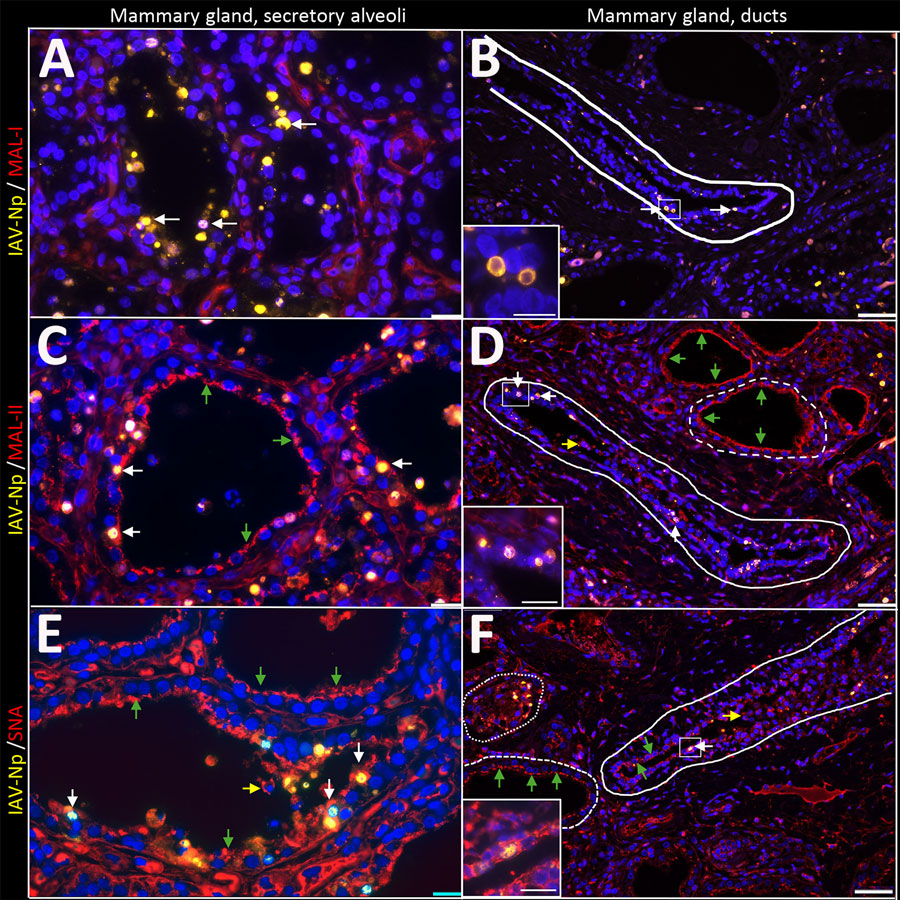Volume 30, Number 7—July 2024
Research
Sialic Acid Receptor Specificity in Mammary Gland of Dairy Cattle Infected with Highly Pathogenic Avian Influenza A(H5N1) Virus
Figure 7

Figure 7. Infected region of the mammary gland from a US dairy cow infected with highly pathogenic avian influenza A(H5N1) virus, labeled with IAV-Np (yellow pseudocolor, DyLight 594), individually duplexed with MAL-I (red pseudocolor, Alexa Fluor 647), MAL-II (red pseudocolor, Alexa Fluor 647), and SNA (red pseudocolor, Alexa Fluor 647) using fluorescent staining. Representative merged images of IAV-Np/MAL-I (A, B), IAV-Np/MAL-II (C, D), and IAV-Np/SNA (E, F) are shown. Moderate to intense intranuclear and intracytoplasmic IAV-Np labeling (yellow, white arrows) was observed in epithelial cells lining the secretory alveolus of the mammary gland; however, no MAL-I labeling was detected (A). Rare, moderate intranuclear IAV-Np labeling (yellow, white arrows), but no MAL-I labeling was observed in epithelial cells lining the interlobular duct (solid white outline) (B). Intense, apical, fibrillary MAL-II labeling (green arrows) was observed in the epithelial cells lining the secretory alveoli of infected mammary glands (C). IAV-Np labeling was co-labeled with MAL-II in individual epithelial cells (white arrows). IAV-Np labeling (white arrows) was observed in epithelial cells of interlobular ducts (solid white outline) (D). MAL-II labeling was not observed in interlobular ducts but was detected in the unaffected secretory alveoli (dashed white outline) (D). Intraluminal cells with cytoplasmic MAL-II labeling were observed (yellow arrow) (D). Intense, apical, granular, membranous to cytoplasmic SNA labeling (green arrows) was observed in the epithelial cells lining the secretory alveoli of infected mammary glands (E). IAV-Np intranuclear labeling was co-labeled with SNA in individual epithelial cells (white arrows) in the secretory alveoli (E). SNA (green arrows) and IAV-Np (white arrows) were observed in epithelial cells of the interlobular ducts (dashed or solid white outline) and were co-labeled to individual ductal epithelial cells (F). Sloughed intraluminal cells had membranous SNA labeling (yellow arrows). Adjacent secretory alveoli had prominent SNA labeling (dashed white outline). The dotted white outline highlights a severely affected secretory gland (F). Insets highlight white boxed areas in panels B, D, and F. Scale bar indicate 20 μm (A, C, E), 50 μm (B, D, F), and 20 μm (insets). IAV-Np, influenza A virus nucleoprotein; MAL, Maackia amurensis lectin; SNA, Sambucus nigra lectin.
1These first authors contributed equally to this article.